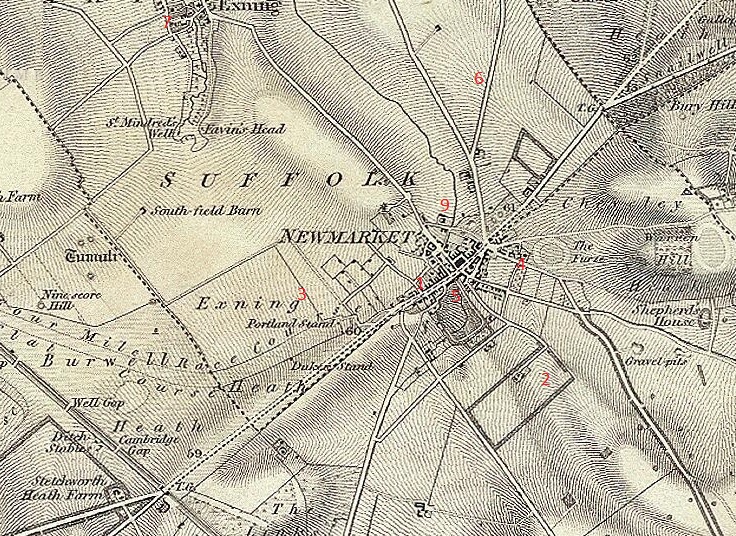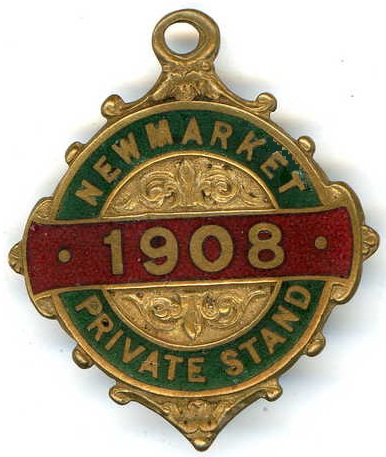1890-1911 George Barrow
George Barrow, son of Newmarket veterinary doctor Richard Barrow and his wife Elizabeth Neal, also became a vet. He married Elizabeth Rayner at Newmarket St Mary's on 5th April 1877 and the couple moved to a practice in Marlborough, Wiltshire. However, they returned to Newmarket in 1890, residing and practicing at Marlborough House which, at that time, was on the Upper Station Road. He was called upon by the horse racing world on numerous occasions to verify the ages of horses, especially those owned by Baron de Rothschild in 1892. He was involved in politics, and was a key signatory in the appointment of Mr Henry Brassey, of Sefton Lodge, as the Unionist candidate for the Newmarket Division. George Barrow died of heart failure at Marlborough House on Tuesday 21st February 1911, although an inquest into his death concluded that it was due to taking chloroform, recording it as death by misadventure.

1912-1935 William Watts
In 1912 William Watts and his wife took over Marlborough House where he kept a stable of horses, some of which were used for stud duty. During the War William joined His Majesty's Armed Forces, although Mrs Watts remained at Marlborough House. In November 1918 he instructed the auctioneer Mr O E Griffiths to sell his livery as well as 8 well-built carriages and a 16-20 horse power Gladiator motor car. By December 1922 William had returned from his duties and ran stables and the stud, while his wife regularly advertised for help with household chores. Their son Geoffrey arrived during their time at Marlborough House, and he was a gifted musician winning local and county prizes in the early 1930s.
1936-1943 Ryan Jarvis, Willie Jarvis
In the mid-1930s William Jarvis purchased Marlborough House with a view to using it as his retirement home once he gave up training. In 1936 his son Ryan began training at Marlborough House until the Second World War intervened, training his first winner Alexdream 4/11 fav, owned by Colonel H E Hambro and ridden by Harry Blackshaw, at Birmingham on Monday 2nd November 1936.
Ryan had served his training apprenticeship with father Willie at Egerton House Stables, and with his uncle Fred Butters at Kingsclere. Ryan is also thought to have taken over some boxes at Cadland just before the outbreak of War, because newspaper reports suggested that when Fred Butters moved from Kingsclere to Cadland in 1939 he was taking over boxes vacated by Ryan. Ryan was called up to active service in the Grenadier Guards, and sadly Willie Jarvis died in 1943. However, Ryan resumed his training career in 1946 at Clarehaven Lodge, taking on a lease from Sir Alfred Butt after the War and, in June 1949, he made a conscious decision to not train any National Hunt horses during that winter, preferring to keep spare boxes to welcome yearlings. When the lease ran out in 1951 Ryan moved to Phantom House.
Alec Waugh, son of Richard Waugh who trained in Germany for the Kaiser, and nephew to Dawson and Tom Waugh, trained a string of 40 horses in Germany before the First World War, but once the War broke out he was interned at Ruhleben. At the end of the War Alec returned to Newmarket and in the 1925 season he trained 8 jumpers at Osborne House. The horses included Mr Reg Day's Mentagne, Mr Dawson Waugh's Malpas and Lt-Colonel Leake's Starosta. He returned to Germany in the 1930s, but was back training in England by the mid-1940s at Marlborough House.
October 1945- 46 Ryan Jarvis
After being demobbed from service in the Grenadier Guards Ryan returned to the family home and resumed his training career. However, he was only at Marlborough House for a short while before he took over at Clarehaven in 1946.
For over 4 centuries racing has been staged in Newmarket, but how have the racecourses evolved from an initial starting point at Fleam Dyke Pumping Station, some 8 miles from the town, with a winning post barely 200 metres from the town centre, into two world recognized, excellent racecourses and a universal acceptance that Newmarket is the Headquarters of racing?
To access an interactive racecourse map showing over 50 individually named racecourses CLICK HERE. The map will enable you to:-
1. Determine when extended races over 8 miles, 6 miles and 4 miles began to be replaced by the courses now visited by thousands annually;
2. Consider how the challenge of crossing the Devil's Dyke was overcome;
3. Contemplate why the town no longer has a steeplechase course despite having at least 5 courses during the past 2 centuries;
4. Examine the practicalities of having up to 48 starting posts and winning posts;
5. Appreciate that it was not financially viable to have an open racecourse spread widely across the heath, with a finishing post barely 200 metres from the town centre;
6. Research how and why the Cambridgeshire Handicap has been contested over 3 different courses.
NOTE: The map does not make mention of 2 particular courses:-
(i) Sefton Course (also known as the Cambridge Road Course)
Source: 1970 Raceform.Used from 1959 to 1975.
(ii) New Circular Course
The Circular Handicap was run on Friday 29th October 1875 on the New Circular Course of about two miles.
Source: London Standard (30th October 1875): ''the horses started near the Turn of the Lands, ran back way of the Cambridgeshire Course towards the Ditch, and afterwards proceeded down the side of the Tan Gallop, and turned into the Rowley Mile near the Bretby Stakes starting post, finishing at the stand at the end of the flat. Except in the hollow near the Cambridgeshire start the runners should have been visible all the way if the sky had been bright and clear''.
Another report hoped that the Circular Handicap would become a feature in future programmes, as it would be contested in front of the new grandstand which would be completed in about a year and would be able to accommodate thousands.
(I am grateful to Tim Cox for bringing attention to these 2 courses.)
Enjoy researching the intriguing history of Newmarket and its many racecourses.

1948-March 1977 Isabel Jarvis
Having purchased Marlborough House as his retirement insurance in 1935 William Rose Jarvis continued to train at Egerton House Stables. Unfortunately, William died in 1943 and was unable to realise his dream of retiring at Marlborough House, although his wife Isabel was allowed to continue to live at Egerton House for the duration of the Second World War. She, and her daughter Bridget, who later married jockey Bill Rickaby, were in a position to move back to Marlborough House from Egerton, with Isabel able to rent out the stables. She lived there until her death in March 1977.
1946-1950 Alec Waugh
Alec Waugh, son of Richard Waugh who trained in Germany for the Kaiser, and nephew to Dawson and Tom Waugh, trained a string of 40 horses in Germany before the First World War, but once the War broke out he was interned at Ruhleben. At the end of the War Alec returned to Newmarket and in the 1925 season he trained 8 jumpers at Osborne House. The horses included Mr Reg Day's Mentagne, Mr Dawson Waugh's Malpas and Lt-Colonel Leake's Starosta. He returned to Germany in the 1930s, but was back training in England at the end of the Second World War, renting Marlborough House Stables and using it as an overflow yard during his spell at St Gatien, remaining in place until 1950.


1957 Basil Foster
Basil Foster was born in Doncaster and began training in 1951 at Rectory Farm, The Ridgeway in Enfield. In 1955 he trained a steeplechaser, Joe Holland, to victory, and he was so enamoured with the horse that when he moved to Lansdowne House Stables, he renamed the house Holland House, a name which has been maintained ever since. It is believed that he rented stables from Isabel Jarvis at Marlborough House on his immediate return to Newmarket, prior to moving to Lansdowne House.
December 1962 W J Combes
In December 1962 W J Combes, who at one time kept his horses with Peter Thrale at Epsom, decided to train his own horses at Marlborough House Stables.
Harry Thomson Jones
For a period Harry Thomson Jones used the stables at Marlborough House as his overflow yard, putting his assistant Don Cantillon in charge.
Jeff Pearce
Jeffrey Norman Pearce was born at Thornbury in Worcestershire on 6th October 1947 to working class parents who bought him a pony which changed his life and set him on the path to becoming a jockey. He entered the world of racing as an apprentice to Toby Balding and had his first ride in public in a novice chase at Towcester on 7th October 1967. It was not a successful beginning as the horse refused. It was to be almost 5 years before he rode his first winner, Fascination at Plumpton on 21st February 1972, the first of about 90 career wins, but in 1981 he suffered one fall too many on Merchant Tubbs at Southwell and sustained career ending injuries. He turned his hand to training, serving as assistant to Frankie Durr for 5 years at Fitzroy House Stables in Newmarket before taking out a licence in his own name in 1986. He had a short spell at Marlborough House before moving on to Wroughton House Stables.
1993-1995 Vacant
For a few years the stables remained vacant for a period, although Sir Mark Prescott used it as an overflow yard until Don Cantillon, who knew the yard well because he was in charge of it when Harry Thomson Jones used it as an overflow yard, returned in 1998 to train in his own right.
Throughout his time in Newmarket Sir Mark Prescott was associated with Heath House Stables where he has always operated with a small, select string, but before Don Cantillon moved into Marlborough House Stables in 1998, Sir Mark used it as an overflow yard.
1998 Don Cantillon
Don Cantillon, born in Cork, proved himself to be a handy amateur rider before making his way to Newmarket, lodging at the Rutland Arms and enquiring which of the many stables trained National Hunt horses. He began riding out for Harry Thomson Jones and rode over 100 winners over a 14-year period with Tom Jones at Green Ridge Stables, the majority in point-to-point races. Don was put in charge of a small stable of horses at Marlborough House which Tom Jones used as an overflow yard, having previously gained experience in California after completing his studies at Worcester Agricultural College. Don successfully applied for a permit to train, basing himself at Hackness Villa, and making a name for himself for grooming difficult horses. He had a special skill which enabled him to run up sequences of wins with a number of horses, including Pegasus Bay, Sea Breaker, Stratton and La Estrella, who broke the record for most wins on the all-weather circuit when he recorded win number 27 aged 13.
2015-17 Denis Quinn
Denis Quinn was in love with racing from an early age, winning many point-to-point races and holding an amateur rider's licence. He gained experience at Jenny Pitman's stables, widening his experience by working at Belmont Park. He moved to England towards the end of 2013 and was successful in applying for a licence to train on the Flat and over jumps, taking up his first post in 2015 at Marlborough House Stables. He then moved to Stockbridge House Stables where he had success with Rockies Spirit on the Flat, and Stonecoldsoba and Shining Romeo over hurdles.
2018-present Louise Allen
Louise Allan was brought up in a farming environment at Thorney, near Peterborough and rode work for the Classic winning local trainer Pam Sly. Pam won the 2006 1000 Guineas with Speciosa (SR 1844), the 10/1 winner ridden by Micky Fenton. Louise made a name for herself riding over 70 winners of point-to-point races and hunter chasers before sensing the time was right for her to apply for her own licence. She first held a licence in October 2011, operating from the side yard of Brickfield Stud. She now holds a dual-purpose licence and, since 2018 has been based at Marlborough House Stables, which she is proud to accept is one of the smallest, yet best run, stables in Newmarket.



